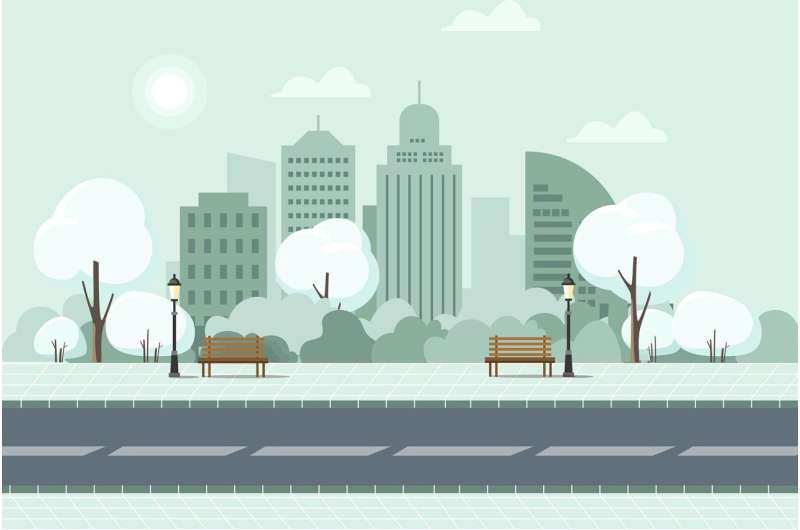This article has been reviewed according to Science X's editorial process and policies. Editors have highlighted the following attributes while ensuring the content's credibility:
fact-checked
trusted source
proofread
Growing rural-urban divide exists only among white Americans

Over the past 30 years, the American political landscape has been characterized by a growing divide between rural and urban voters, almost as if they're on two opposing teams, according to Suzanne Mettler, the John L. Senior Professor of American Institutions in the College of Arts and Sciences (A&S).
But the divide is confined largely to white Americans, Mettler and collaborators have found in an examination of the racial and ethnic facets of the trend.
When it comes to politics, Black and Latino residents of rural America differ far less, if at all, from their urban counterparts than do non-Hispanic white residents, the researchers report. With one in four residents of rural America now identifying as nonwhite, the study's findings raise concerns about political representation of Black and Latino Americans and highlights a need for further research on rural people of color broadly, including racially marginalized groups beyond Black and Latino people.
"A Rural-Urban Political Divide Among Whom? Race, Ethnicity, and Political Behavior Across Place" published in Politics, Groups, and Identities on March 31, with a summary of the findings appearing in the United States Politics and Policy blog of the London School of Economics, June 7. Mettler is corresponding author, and co-authors are doctoral students Trevor E. Brown, Marissa Rivera and Gisela Pedroza Jauregui.
"Rural and urban Americans began moving apart politically in the late 1990s, and the division has widened and deepened since then, transforming the nation's politics," Mettler said. "We wanted to know whether all Americans, regardless of race and ethnicity, are swept up in this growing cleavage."
Mettler and Brown are writing a book investigating the divide.
"The rural-urban political divide is a major problem threatening the foundations of American democracy for everyone," Brown said. "But the stakes seem especially high for people of color in rural areas. They tend to be ignored by our two major political parties and, as a result, lack much voice in the political process."
From 1970 through the 1990s, there was relative balance between Democratic and Republican leanings in rural areas, the researchers said, but "since the late 1990s, rural and urban areas have increasingly become bastions of support, respectively, for Republicans and Democrats."
During the same time period, the share of the U.S. population identifying as nonwhite increased in both urban areas and rural, so that by the 2020 census, 25% of rural residents identified as nonwhite, the study points out.
To find out whether a rural-urban divide exists among people of color, the researchers analyzed data from the Cooperative Election Studies survey, which includes a wide array of policy questions and a large sample size. Using survey respondents' county information, they were also able to designate each as living in a "rural" or "urban" area, according to the White House Office of Management and Budget.
The study compared Black, Latino and white voters, urban and rural, between 2008 and 2020. Black support for the Democratic Party was very high—around 90%—in both rural and urban areas from 2008 to 2020, with support for Republicans consistently very low. Latino support for Democrats remained consistent nationally for this period with only a few points of variation among both rural and urban voters.
White support in urban areas was split almost 50% Democrat/50% Republican from 2008 to 2020, with a slight Republican edge.
It was only among white voters that a large and growing disparity appeared between rural and urban residents, the researchers found.
Why haven't rural Black and Latino Americans shifted to the Republican party alongside their white peers? The question needs further study, the researchers said, theorizing that varying degrees of "linked fate"—a term coined by political scientist Michael Dawson, implying the belief that one's individual fate is tied to that of their racial or ethnic group—can help explain why Black and Latino Americans do not diverge.
Another possible explanation is a theory, proposed by political scientist Ismail K. White and Chyrl N. Laird, that Black Americans who hold more conservative views follow social pressures to continue supporting the Democratic Party.
"Untangling the mechanisms that hold the voting behavior of rural and urban Black and Latino Americans together is a crucial avenue for future research," the researchers wrote.
More information: Trevor E. Brown et al, A rural-urban political divide among whom? Race, ethnicity, and political behavior across place, Politics, Groups, and Identities (2024). DOI: 10.1080/21565503.2024.2328551
Provided by Cornell University



















